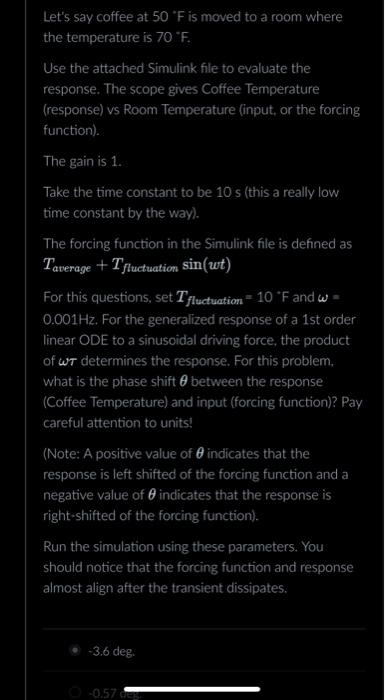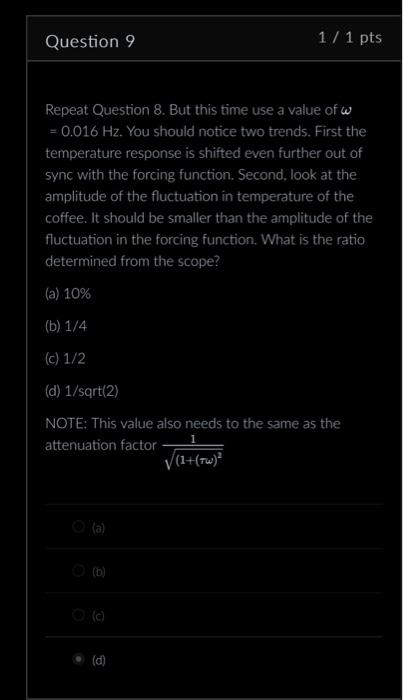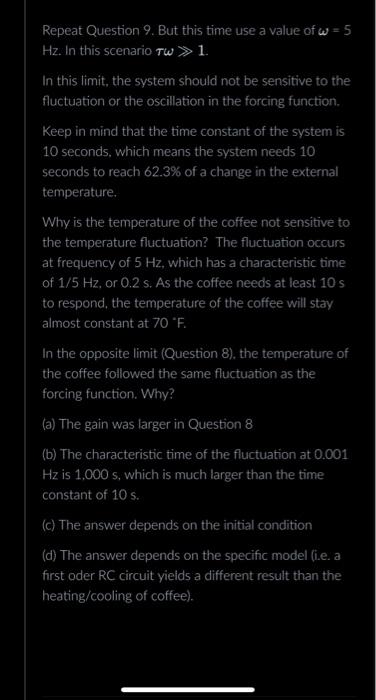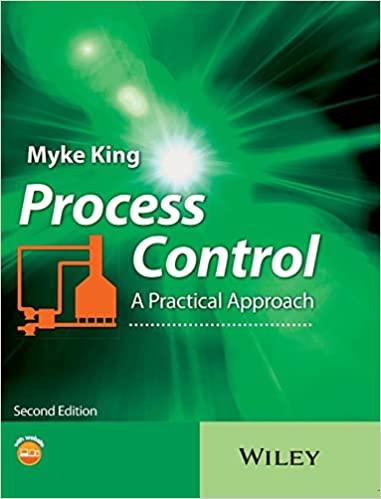Let's say coffee at 50F is moved to a room where the temperature is 70F. Use the attached Simulink file to evaluate the response. The scope gives Coffee Temperature (response) vs Room Temperature (input, or the forcing function). The gain is 1. Take the time constant to be 10s (this a really low time constant by the way). The forcing function in the Simulink file is defined as Taverage+Tfluctuationsin(wt) For this questions, set Tfluctuation=10F and = 0.001Hz. For the generalized response of a 1st order linear ODE to a sinusoidal driving force, the product of determines the response. For this problem, what is the phase shift between the response (Coffee Temperature) and input (forcing function)? Pay careful attention to units! (Note: A positive value of indicates that the response is left shifted of the forcing function and a negative value of indicates that the response is right-shifted of the forcing function). Run the simulation using these parameters. You should notice that the forcing function and response almost align after the transient dissipates. - 3.6deg. Question 9 Repeat Question 8. But this time use a value of =0.016Hz. You should notice two trends. First the temperature response is shifted even further out of sync with the forcing function. Second, look at the amplitude of the fluctuation in temperature of the coffee. It should be smaller than the amplitude of the fluctuation in the forcing function. What is the ratio determined from the scope? (a) 10% (b) 1/4 (c) 1/2 (d) 1/sqrt(2) NOTE: This value also needs to the same as the attenuation factor (1+()21 (d) Repeat Question 9. But this time use a value of =5 Hz. In this scenario 1. In this limit, the system should not be sensitive to the fluctuation or the oscillation in the forcing function. Keep in mind that the time constant of the system is 10 seconds, which means the system needs 10 seconds to reach 62.3% of a change in the external temperature. Why is the temperature of the coffee not sensitive to the temperature fluctuation? The fluctuation occurs at frequency of 5Hz, which has a characteristic time of 1/5Hz, or 0.2s. As the coffee needs at least 10s to respond, the temperature of the coffee will stay almost constant at 70F. In the opposite limit (Question 8), the temperature of the coffee followed the same fluctuation as the forcing function. Why? (a) The gain was larger in Question 8 (b) The characteristic time of the fluctuation at 0.001 Hz is 1,000s, which is much larger than the time constant of 10s. (c) The answer depends on the initial condition (d) The answer depends on the specific model (i.e. a first oder RC circuit yieids a different result than the heating/cooling of coffee). Let's say coffee at 50F is moved to a room where the temperature is 70F. Use the attached Simulink file to evaluate the response. The scope gives Coffee Temperature (response) vs Room Temperature (input, or the forcing function). The gain is 1. Take the time constant to be 10s (this a really low time constant by the way). The forcing function in the Simulink file is defined as Taverage+Tfluctuationsin(wt) For this questions, set Tfluctuation=10F and = 0.001Hz. For the generalized response of a 1st order linear ODE to a sinusoidal driving force, the product of determines the response. For this problem, what is the phase shift between the response (Coffee Temperature) and input (forcing function)? Pay careful attention to units! (Note: A positive value of indicates that the response is left shifted of the forcing function and a negative value of indicates that the response is right-shifted of the forcing function). Run the simulation using these parameters. You should notice that the forcing function and response almost align after the transient dissipates. - 3.6deg. Question 9 Repeat Question 8. But this time use a value of =0.016Hz. You should notice two trends. First the temperature response is shifted even further out of sync with the forcing function. Second, look at the amplitude of the fluctuation in temperature of the coffee. It should be smaller than the amplitude of the fluctuation in the forcing function. What is the ratio determined from the scope? (a) 10% (b) 1/4 (c) 1/2 (d) 1/sqrt(2) NOTE: This value also needs to the same as the attenuation factor (1+()21 (d) Repeat Question 9. But this time use a value of =5 Hz. In this scenario 1. In this limit, the system should not be sensitive to the fluctuation or the oscillation in the forcing function. Keep in mind that the time constant of the system is 10 seconds, which means the system needs 10 seconds to reach 62.3% of a change in the external temperature. Why is the temperature of the coffee not sensitive to the temperature fluctuation? The fluctuation occurs at frequency of 5Hz, which has a characteristic time of 1/5Hz, or 0.2s. As the coffee needs at least 10s to respond, the temperature of the coffee will stay almost constant at 70F. In the opposite limit (Question 8), the temperature of the coffee followed the same fluctuation as the forcing function. Why? (a) The gain was larger in Question 8 (b) The characteristic time of the fluctuation at 0.001 Hz is 1,000s, which is much larger than the time constant of 10s. (c) The answer depends on the initial condition (d) The answer depends on the specific model (i.e. a first oder RC circuit yieids a different result than the heating/cooling of coffee)









